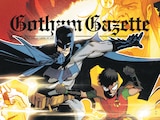Chances are, even if you've somehow never read a comic, seen a movie, or watched a TV show about Superman, you probably still understand a thing or two about Kryptonite. It's one of the most well-known and recognizable minerals on the planet, despite being totally fictional, to the point that the word itself has been folded into pop culture, from song lyrics to idioms, and crossing genres, mediums and cultures.
In short, anybody who knows anything about Superman knows Kryptonite too, and everybody knows something about Superman.
But there's more to the Man of Steel's one true weakness than meets the eye—in fact, there's a lot more. So, get your lead boxes ready and strap yourselves in, it’s time to take a closer look at the wild history of Superman's Achilles heel.

Kryptonite was an unexpected addition to the mythology of the DC Universe. In fact, it didn't even get its start on the pages of a comic—instead, it was the 1943 Adventures of Superman radio show that first introduced it. That’s right, a radio show. Sure, it may sound a little strange to us now, but back then the Superman radio show was just as—if not more—popular than the comics themselves. Keep in mind that this was the heart of the Golden Age before things like continuity and shared universes were really established the way we know and recognize them today, so stories about Superman across all different mediums just kind of did their own thing, and in that way, they helped each other grow and change.
Kryptonite's inclusion in the radio show wasn't just for narrative development. The recording schedule for episodes was a lengthy and daily process that required a huge time commitment from the voice actors. By giving stories a way to take Superman out of commission, they were also giving their actors a chance to take breaks and days off.
It took six years after its radio introduction for Kryptonite to make the leap to the comics and it still wasn't the glowing green rock you're thinking of. It made its on-page debut in SUPERMAN #61 in 1949, but this early version was actually red in color—not to be confused with the now well-known Red Kryptonite that would be introduced several years later. It took another two years for "standard" Kryptonite to get its green color, in 1951 with ACTION COMICS #161.

Over time, Kryptonite's mythology shifted and changed as it became more and more popular. Different variations and colors started being introduced all through the ’50s and ’60s…and by "different variations," we mean just about every color or combination you could think of.
There was Red Kryptonite, which caused aggressive and odd behavior, White Kryptonite that killed plants, Blue Kryptonite which affected Bizarro Kryptonians, Red-Gold to remove memories, Black which split people into good and evil selves, Jewel, Magno, Anti, X…you name it. If a story needed something done, there was a Kryptonite to do it.
This was the height of the Silver Age where "imaginary stories" (stories that didn't exist or fit into any specific continuity, usually dreams or delusions by characters) reigned supreme, so there was really no limit to what could be done. Kryptonite provided an easy, versatile and virtually limitless way to put the Man of Steel and his allies through all sorts of weird and wild ringers. Exposure to Pink Kryptonite could switch Superman’s gender while Orange Kryptonite could give him the powers and abilities of an animal. Scientifically inclined villains could even manufacture their own versions artificially, tailoring it to whatever scheme they had come up with. The Earth, it would seem, was really just one giant, rock candy Kryptonite buffet.

The Silver Age's Kryptonite fever got so out of hand that the dawn of the Bronze Age saw a story where every Kryptonite fragment on Earth got sweepingly nullified into useless "k-iron" just to keep things from snowballing any further in 1971.
Of course, it didn't just go away for good. After the mass k-iron transmutation and the giant, continuity shifting events of CRISIS ON INFINITE EARTHS, Kryptonite got another revamp, this time with a foundation that was a bit more solid. In the Post-Crisis DCU, all Kryptonite was derived from one natural form (the green kind), and could only be modified or crafted into other variations artificially. This is how it became the limited and highly valuable resource on Earth we know today, and why we don't see the other colors and combinations cropping up all that often.
Still, if its past is any indication, the potential for change and evolution in Kryptonite's forms, effects and applications are virtually limitless. From unexpected origins to tumultuous development, this glowing radioactive rock from space has proven to be almost as endearing and ubiquitous as Big Blue himself. And after eighty years as the world's most recognizable superhero, it all but figures he'd have the world's most recognizable weakness.
Mason Downey writes about comics, movies and superhero history for DC.com. Look for more of his work on GameSpot, IGN and Polygon and follow him on Twitter at @rustypolished.















